The Cedar Log Cabin
The Story of Living In & Restoring a Settler's Log Cabin
Living the Settler Life
An Unexpected Life
Although I had wanted to live in country with the fresh air to help with the lung problems my cat Cornelius suffered from, and to spend more time gardening and being closer to nature, I wasn't prepared for how much it turned into living like a settler.
There was the financial hit we had taken on October 31, 2006. Pamela ended up moving to Toronto, and other than a few weekend visits by her each year, I spent the next 4 1/2 years alone with the cats - with minimal resources, a stranger to the area, and no running water.
Things got much worse in late 2008, when the housing market in the US rolled over. The area, was based on two industries: tourism and lumber. When the housing market died, the lumber industry died and tourism slowed down. Also, what was left of my invested money from the my home being sold was depleted even further.
One good thing that came from all this time alone, is I came to see myself differently – more clearly & honestly. Very few people have the chance to be alone for any stretch of time, whereas I spent weeks at a time with no human contact, except the once a week, hour long coffee visit with Bill and Elva – the couple across the road.
It wasn't easy to see myself in the third person - to see myself from an outside perspective. I can't speak for anyone but myself, but it was a painful process. I wondered if that is why some people go mad when living alone for extended periods. I was also aware that spiritual seekers often seek time alone, so it could go both ways - either make me a better person, or make me go mad. I like to think it made me a better person, although my confidence was badly shaken by how poorly things seemed to go.
I wasn't absolutely alone. There were my two cats we moved up there with. There was Felemur, a very old Lynx Point Siamese. And there was a great friend, and genuinely remarkable tuxedo cat named Cornelius. Cornelius was so remarkable, I've written a separate book about him. He changed me greatly, and his "no problem" attitude, was something I looked up to. He wasn't a dependant, he was a friend. I owe him a lot of gratitude.
Laundry
When we got the cabin, there was a very old dug well that went down about 15 feet. Most of the time there was water in it, but it had two major issues. One, about 20 years before we bought the cabin, it had been condemned by some authority after testing. Nobody around remembered the reason why. The other problem, was it was about 10 feet from the road – right off the ditch at the fence line. It was not a well that I would have even considered for drinking water.
However, the water looked clear, and when I pumped it dry, you could see water coming up from cracks in the rock at the very bottom of it. The plan had been to get a proper well drilled at some point, but that was one thing that was never done. So the well was used for everything but drinking and cooking when it wasn't frozen.
Electricity was not an issue for washing clothes, but there was no pressurized water. Since there was no pressurized water, I could not use a washing machine. There was the laundromat in town, but I only went to town every couple of weeks, even in the non-winter seasons. Driving was expensive, and I rationed trips, doing everything at once with a well planned list.
With all the renovating, gardening and firewood making, I got my clothes completely dirty every day, often twice a day, so I needed a way of doing laundry at home. When we first moved there, we had brought up with us an old wringer washer that I filled from the well that had a utility pump in it with a garden hose coming out. It worked fine until the wringer washer died a year later.
I would have tried to find an old washing machine, but that would need pressurized water.
One day, after the weekly flyers arrived in the mail box as usual, I was reading them and saw that one of the local appliance stores had a special on front loading washing machines. I joked out loud to myself that they looked like cement mixers. It hit me – why not use the cement mixer to wash the clothes? Sure it couldn't wring the clothes out, but it might be able to wash and rinse them.
So I tried it. It worked, but the clothes kept getting tangled in the three fins inside the mixer. I took the fins out (they were just bolted in), replaced the bolts with smooth headed bolts with the head inside and the nut outside, and gave it another shot. It worked great. I was just blown away. I could even do comforters. To drain the water, all I had to do was put the cement mixer on the slight tilt angle it was designed for pouring cement. The clothes stayed in the machine as the water drained. I drained the water into a 5 gallon bucket, and used the water to water plants. The detergent was biodegradable, so the plants didn't mind.
After a wash, it took about 15 minutes to fully drain, then I put some more water, ran it again as a rinse cycle, drained again, one more rinse cycle, then let it drain for about an hour. By that time, although the clothes were still quite wet, they were no problem to hang on the very heavy duty clothesline I had made out of thick cedar wood.
It was quite an operation, but once I got the rhythm of it, it worked very well. I was still able to use the mixer for making cement, and was in for a happy surprise. The cement mixer without the fins, was now able to mix mortar at the proper consistency, whereas with the fins, it was not. All I had to do for mixing mortar, was leave the shovel in the mixer while it mixed and the action of the mixer with the shovel in it was perfect. I was able to make a thick parge, perfect for doing the walls. Before, I was mixing mortar and parge cement in buckets by hand.
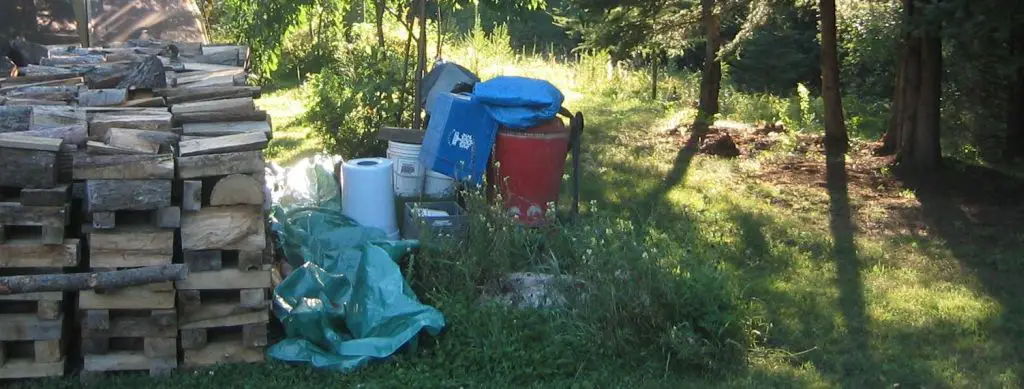
This was my laundry setup. The cement mixer to wash, the blue box to carry the wet laundry to the line, the tarps to cover it, two five gallon buckets to drain water into. I had it hidden behind the woodpile, to hide from the road. I was too embarrassed to have someone find out I did my laundry in a cement mixer.
The Clothesline
One of the things I found out quickly, was that a standard clothesline does not do well with the weight of clothes that have not been cycled through a spin dry. The clothes are so heavy, the line sags badly, or just breaks, and your clothes end up on the ground.
I looked at the pole type clothes dyers in the local hardware store, but it seemed too small and lightweight. I found a picture of one on the web, and decided to make my own. I made it out of local white cedar I found in the woods, and made it exactly the same as the one in the picture on the web.
It worked well, and lasted the entire time I was there. It even spun around. I cut the main pole near the top, sanded the ends smooth, drilled a 1” hole in both cut ends, waxed the ends and holes, put in a piece of 1” steel tube, and set the top back on the pole.
This was another of those things I made for the yard that often caused people to stop and ask if they could take a picture. One day, a woman and her son stopped in, and she wanted to take my picture standing by the clothesline. I didn't know if I should be embarrassed or proud.
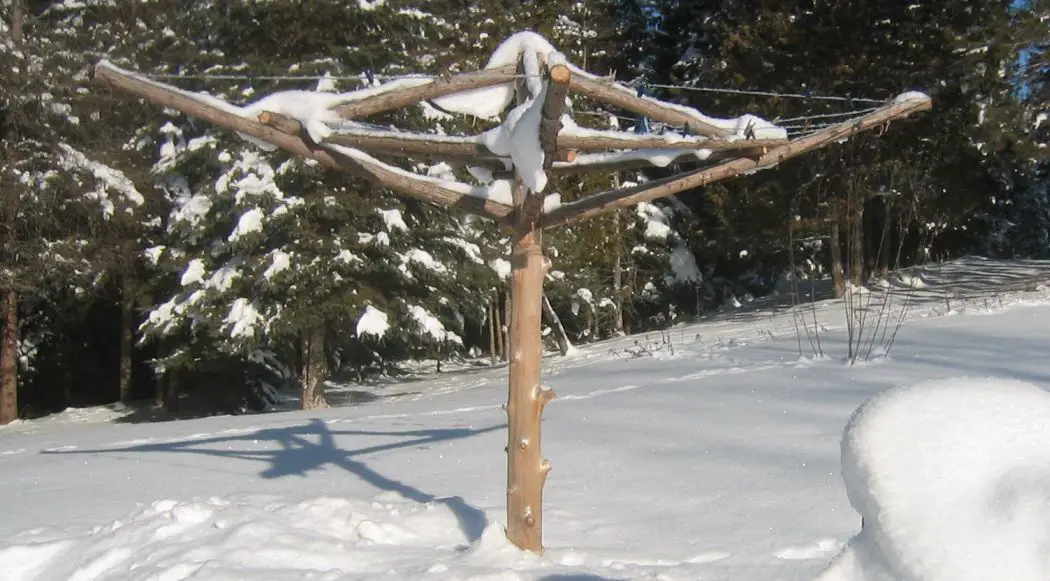
Clothesline in the winter. This is how it looked if you were looking from the perspective of the road. It is bigger than it appears; the four horizontals are about 6 feet long each. The outer four lines were wide enough to hold a queen size comforter without bunching it up. The lines went through holes drilled in the four up tilted horizontals.
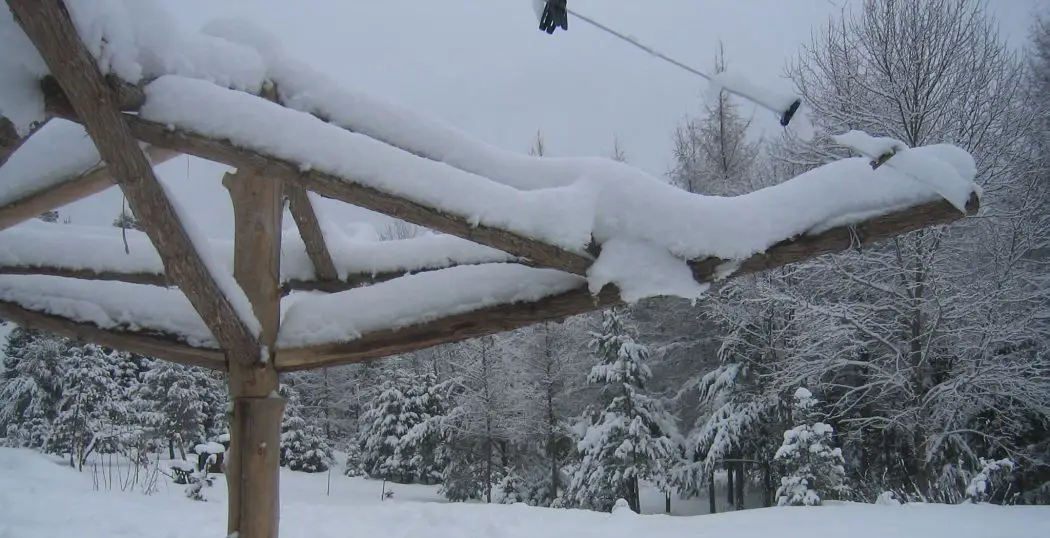
This is a close up that shows construction. If you look at the main post, you will see it is cut. This is where it spun. It spun so easily that it would spin around in a light breeze with clothes on it. All pieces are joined with holes drilled, and hand carved dowels glued in then decking screws to hold it tight. It never gave a hint of problems in the time I used it. I've had four soaking wet comforters, and another full load from the cement mixer on it at one time in a strong wind.
Heat and Cooking
Other than the first six weeks or so, all the heat came from a high efficiency wood stove. There was no electric heat backup, no natural gas lines in the area, and propane was expensive up front and using. Most of the cooking was done on it as well. I had a hotplate and water kettle, and a used electric stove near the end of the time I was there, but over the five years I was there I would say about 75% of all cooking was done with the wood stove. It wasn't a cook stove – a wood stove meant for cooking on, it was a wood heating stove with an opening at the top where you could cook.
I came to really like cooking this way. I have no idea why, but the food tasted better, and it was just fun. There was something very charming about being inside with food on the wood stove while it was snowing outside. Maybe I had seen one too many postcards of idealized life in the country.
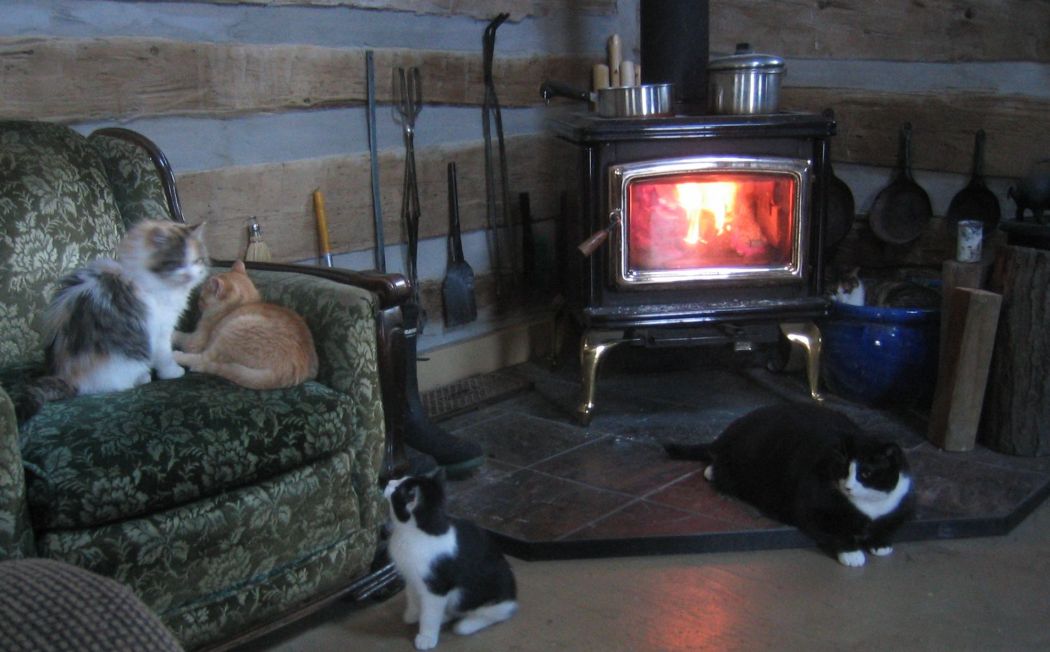
Typical winter day cooking on the wood stove. There is something almost spiritual about cooking on a wood stove in a log cabin in the winter. Cats? What cats? Although life was tough a lot of the time I was in the cabin, happy moments like this stayed with me.
I discovered you could bake inside the stove. All you had to do was have a good fire, let it burn down to coals, put a firebrick on the coals, set what you wanted baked on the firebrick, and watch it through the window until it looked ready.
This system worked very, very well. I had made bread from scratch in the past, and started to do it every third or fourth day, giving me all the bread I needed. When I say from scratch, I mean from the raw Khorasan wheat kernels I grew in the garden, ground into flour in a hand mill, formed into bread and bagels and cooked in the wood stove. It was a huge amount of work, but the cost was basically zero, and the bread was so good and filling. Also, the taste was different in the wood stove. The coals lend a certain taste of wood to the baked goods that you can't reproduce in an electric oven.
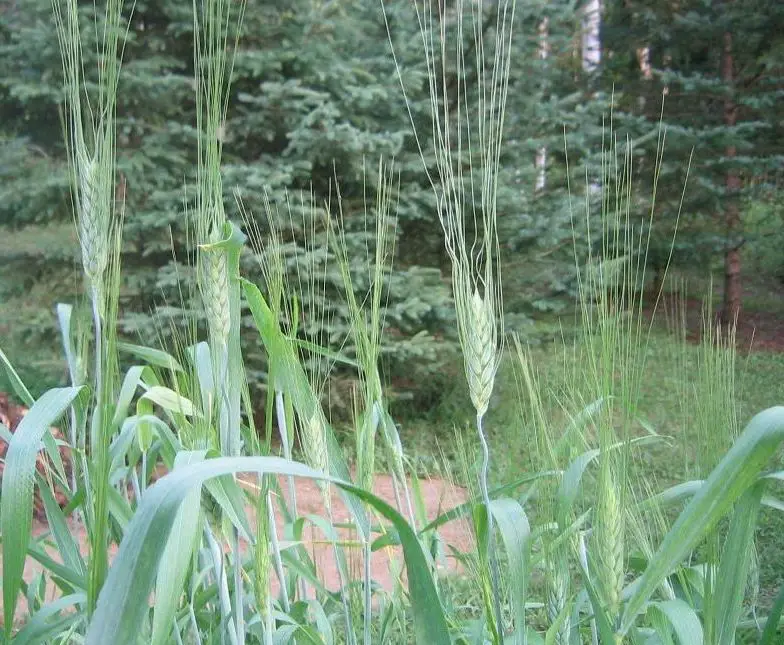
Khorasan Wheat growing in my garden. It is such a beautiful plant, with the tall spikes growing up from where the grain grew, and the “S” curve in the neck. The grain has a pleasing golden tan colour and a nutty taste that makes baked goods taste better.
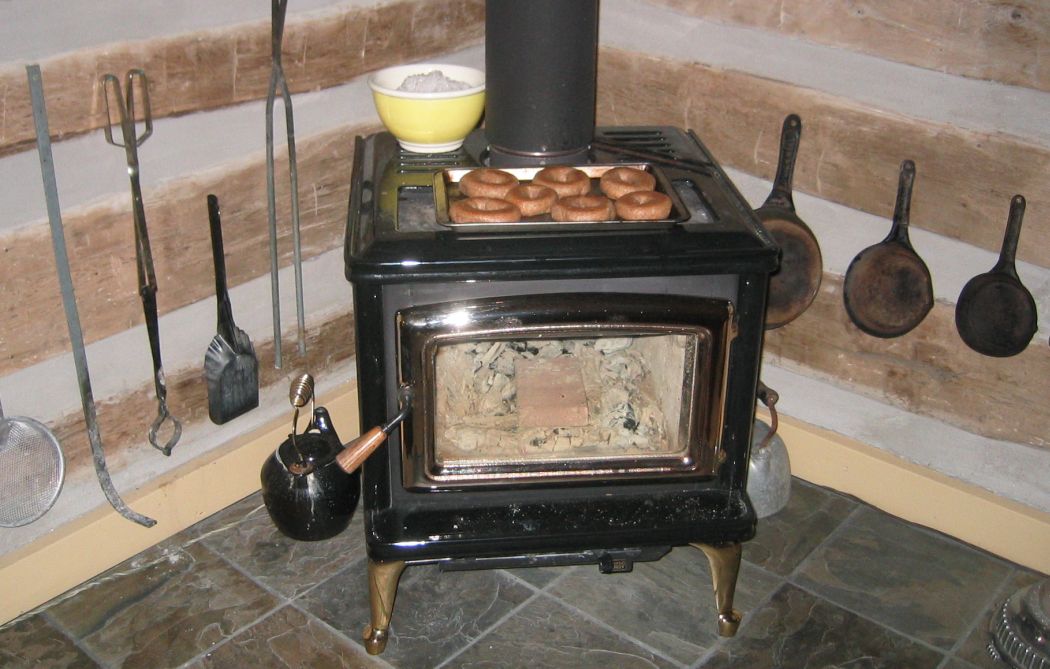
Bagels just taken out of the stove. On top of the coals in the wood stove, you can see a fire brick that I would set the baking tray on. I would watch TV after putting something in the stove, and just keep looking over to see when it was done.
You could bake anything in this stove that you could in a regular oven. Baked potatoes were a regular. One of my favourites, was garden fresh onions, carrots, parsnips and potatoes baked inside covered glass oven ware.
The coals gave heat that was good for up to two hours minimum, and the great thing was, after the baking was done, I'd pull out the firebrick, throw in some wood and the coals would start the fire in five minutes.
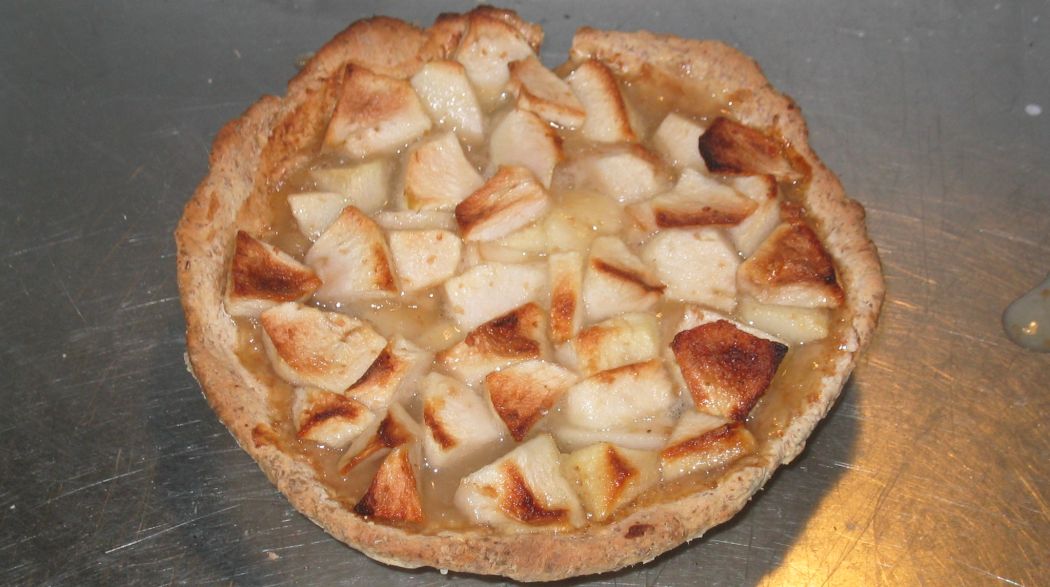
An apple pie just taken out of the wood stove. The dough is made from Khorasan Wheat grown in my garden, and the apples are from the apple tree right outside the back door by the cat pen. The only ingredient that did not come from the yard was salt. I wanted to see what could be made from the yard that wasn't “survival” food. By the way, it was so good I ate the whole thing all at once for supper.
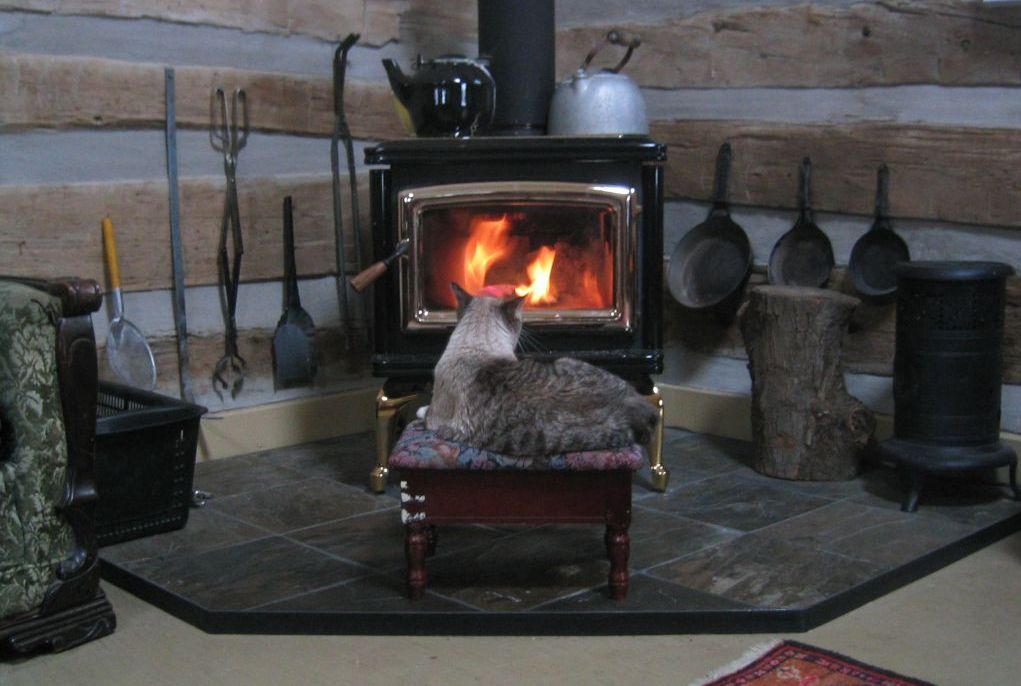
When the stove wasn't being used to cook, which was most of the time, I kept two kettles on the stove to provide humidity. Being in front of a wood stove feels good for sore muscles and tired bones. This was my cat Felemur when he was almost 20 years old. He would get very stiff at this age, and loved to warm his bones by the fire.
Firewood
All this meant a lot of wood was needed. Wood was expensive, I know because when we first moved in, we bought wood for the first year. Wood was about $80.00 per face cord if you picked it up yourself, and 14 cords of hardwood per year was needed, if you included the wood for cooking.
Fairly quickly, I started making my own firewood. There were many trees on the property that needed to be cleaned up. There was that huge white pine that had fallen in a storm, and the the dozen or so trees that it knocked down when it fell. The white pine alone provided wood for about a year.
There were always trees falling in storms up there. There were many nasty storms. Two times in the five years I was there, there were tornadoes. My neighbour behind had just under 100 acres, and he was very happy with me restoring the cabin his grandfather had built, so he let me cut up and take home wood that had fallen in storms that was on his land on the hill behind the cabin.
I spent a lot of time cutting up wood, chopping wood, stacking wood, carrying wood, and of course, cleaning up the mess that bringing in wood creates. There was the dusty issue of cleaning ash from the wood stove. Also, untold numbers of things live in a stacked firewood pile, and a lot end up in the cabin.
Wood heating and cooking is a big job, doing the whole process by yourself. However, it was one of those jobs I enjoyed doing. It was satisfying, and one of the best ways to spend your time on a dry, sunny fall day. I came to the conclusion that the best time to make firewood is in the fall, not for the season coming up, but the one after. Few bugs and nice weather in the fall.
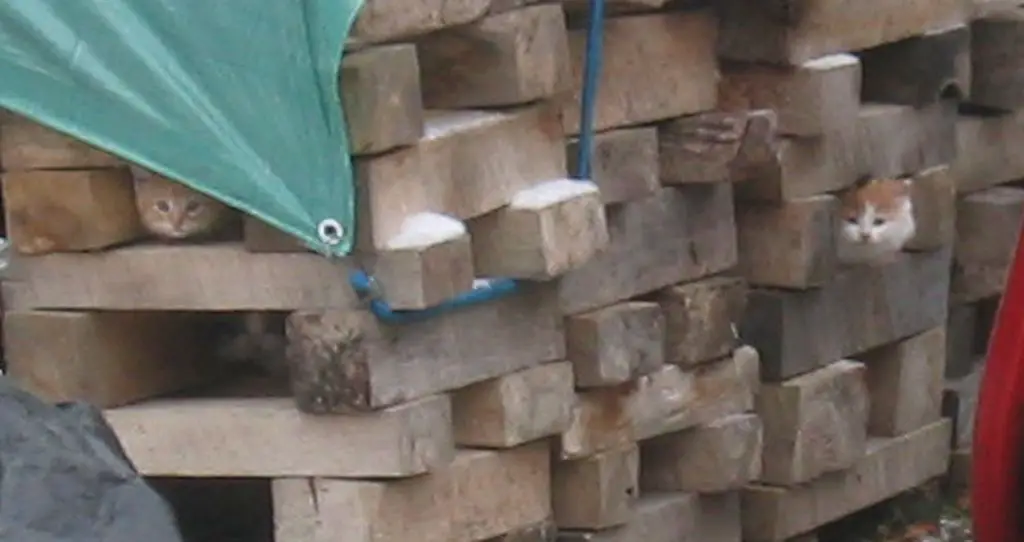
One of many wood piles. This squared wood, Bill my neighbour gave me after I cleaned his yard for him. You never know what critters live in wood piles. Often these things get brought into your cabin. The three (yes, three) critters in this picture somehow got into the cabin and are still with me.
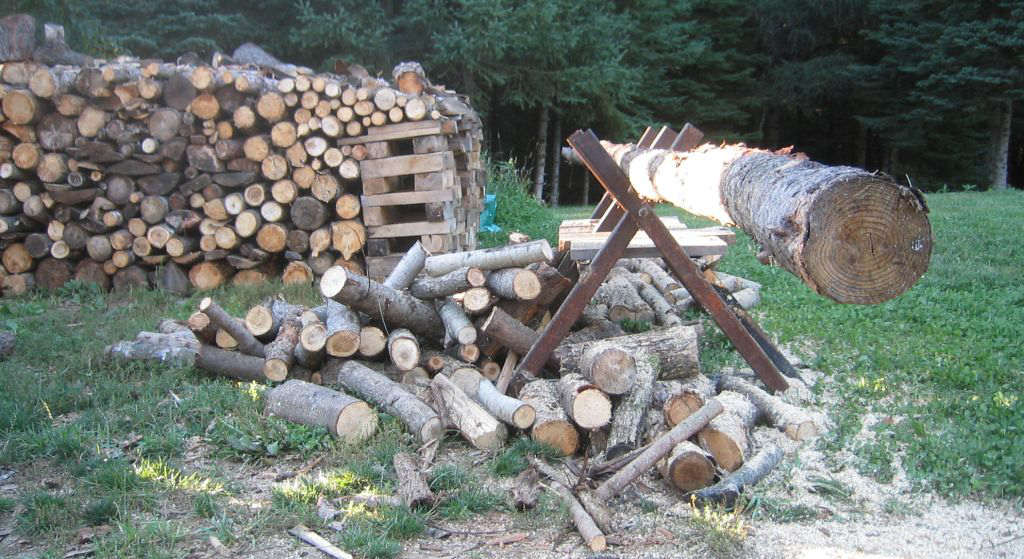
A lot of time was spent in the process of getting enough firewood. Fallen trees in storms was my main source of wood.
Water
Water wasn't something that came from a tap in the cabin. There was a dug well, but that water was only safe for washing clothes, gardening and doing dishes after sitting a little while with bleach added. There was a lot of sulphur in the area, and the well water stunk of it.
When it wasn't too cold, drinking and cooking water came from a tap in town that was put in for tourists to fill their water jugs when they were camping. I made good use of that tap. I would fill around 10 five gallon jugs on one of the “do everything” trips to town. It was very handy to have a pickup truck for this purpose alone.
In the dead of winter, when the tap was often frozen or the pile of ice around it made it almost impossible to get near the tap safely, I would make my own water from snow and boil what I needed for drinking and cooking. I had to make water from snow anyway for washing, cleaning and dishes because the well would freeze.
I had two 50 gallon plastic barrels in the back room. I would go outside with a 5 gallon bucket, fill it tight with fresh snow, come in and dump it in the barrel, go out and do it again and again until the barrel was filled. By the time the snow in one barrel was melted and ready to use, I had to refill the other barrel with snow. By the way, a 50 gallon barrel with packed snow would yield about 10 gallons of water - or less.
There were very few times when I couldn't find enough snow to make water. I was just frugal with my water supply while waiting for snow. It always came.
Foraging for Food and Garden Harvests
Some things I just had to buy from a store, but there wasn't a lot. I got by most of the time on $10 to $15 worth of purchased groceries per week average.
The garden provided a lot of food for most of the year. Squash, potatoes, onions, garlic, sunflower seeds and the Khorasan wheat would keep in the cabin. Kale, parsley and parsnips would keep in the garden with a good snow cover over a little mulch. During the late summer and fall I bought very little at all. Although I averaged $10 to $15 per week, it was basically zero in the summer and fall and more than that in the late winter and spring.
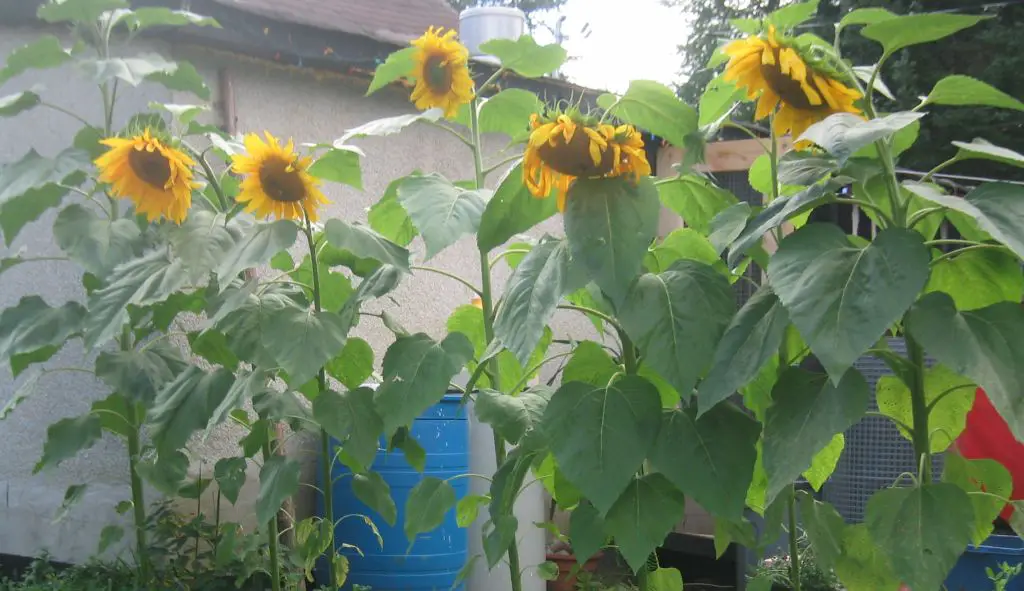
I grew sunflowers for the seeds. Birds got some, but the harvest was still very good.
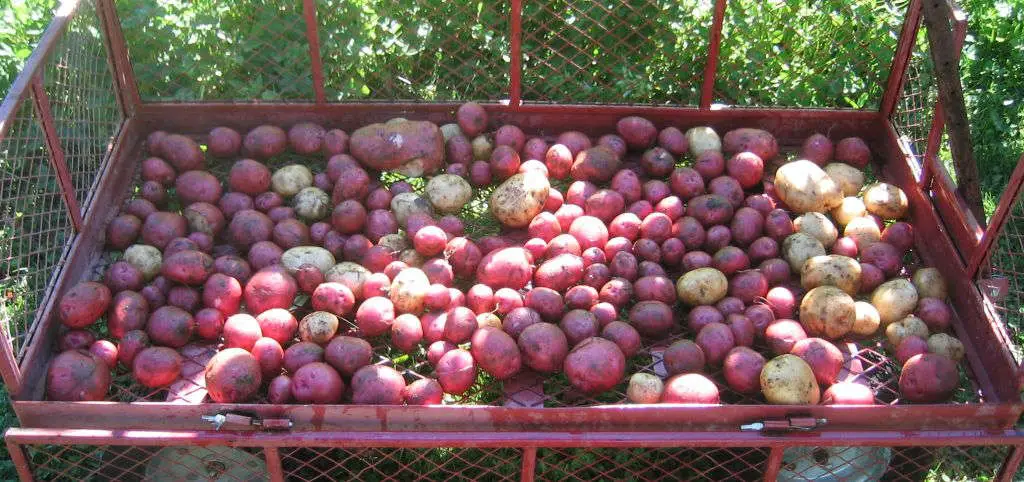
Just starting to harvest potatoes. I was told by locals that only red potatoes grew well in this area, and to my surprise, it was true. I planted half red and half white and this was a typical harvest mix.
One thing that added a lot to the food supply for free was foraged food. I had done it as a hobby in the city, gathering stinging nettles and many other greens, berries, roots, nuts and mushrooms. That knowledge came in very handy in the cabin. There was so much wilderness around, the food supply was basically infinite if you knew what you were looking for.
I got lucky in that jerusalem artichoke was all over the property. I could never exhaust it. The problem with jerusalem artichoke is the tubers don't keep well, so you have to eat them when they are ready in the fall, and a brief period in the spring. In the fall, when they were plentiful, so was everything from the garden. What I did was eat the jerusalem artichoke when they were ready in the fall and keep the potatoes for later as they kept well. You can use jerusalem artichoke as if they are potatoes, so it worked out well.
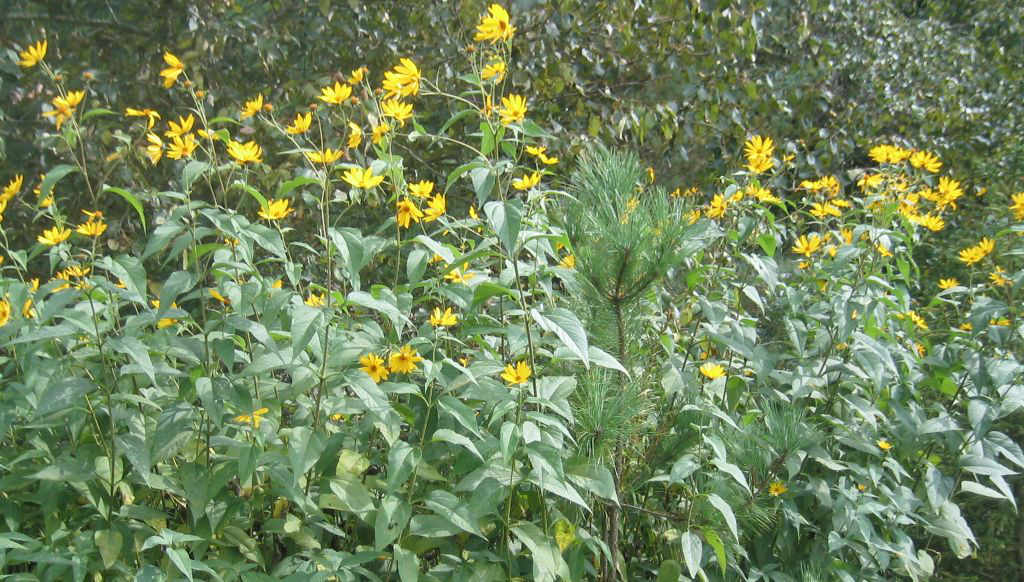
Jerusalem artichokes in the yard by the woods. This is just a fraction that were in the yard. More food than I needed, and they spread every year. They never seemed to have any pest problems, and are beautiful in flower. They are a fantastic found food.
The other bit of luck I had was apples. There were two apple trees within 20 feet of the cabin, one was sweet apples, perfect for eating off the tree, the other had apples that were a bit more tart, but I still loved eating them fresh off the tree, and they were absolutely fantastic cooking apples. They would keep in the cabin until around Christmas.
Funny thing about apples from those trees around the cabin, the apples were almost never wormy. In Southern Ontario, where I was from, found apples from wild trees were always so wormy that you were lucky to find 1 in 20 you could even get a couple of bites from. You did have to compete with raccoons for the apples around the cabin, but I think in the five seasons I harvested apples from those trees, it was rare to find worms. One season, due to a bad frost when the blossoms were out, the harvest was almost nil, but other than that, the tree produced very well and was a great source of food.
I've written a separate book on gathered foods, as I've had decades of experience. It is also on the web at Nature's Restaurant Online.
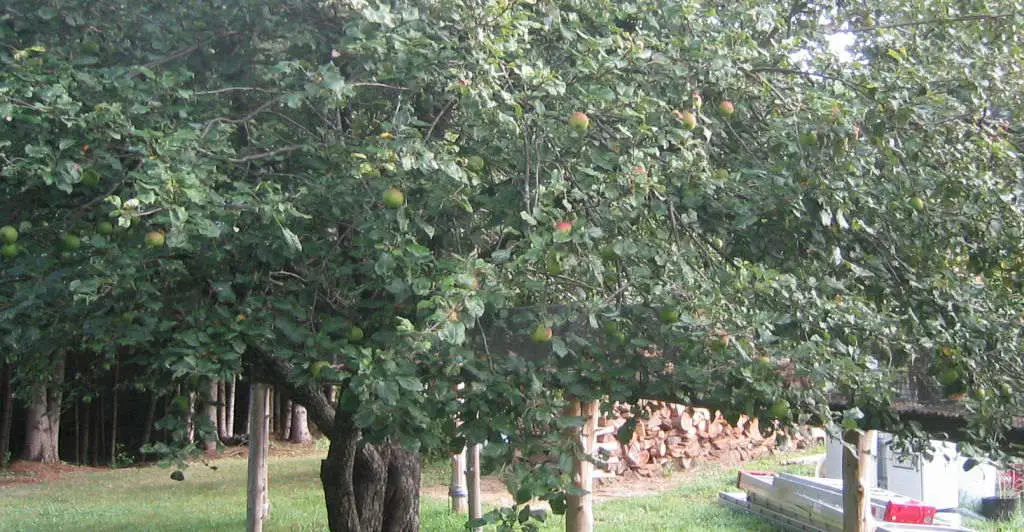
The apple tree right outside the back door produced a very good harvest every year but one during the time I was living in the cabin. I never once sprayed, or did anything but trim branches and harvest, yet I rarely found a wormy apple. The apples were tart, but I liked them, and they were great cooking apples. You can see the cat tunnel running under the tree on the right of the picture.
Wildlife
The area the cabin was in was surrounded mainly by forest. To the north, was the town of Bancroft, which was about 12km by road one way, and all around were scattered lakes inhabited by tourists in the summer, but mostly it was woods. To the south especially, was woods and marshes with the odd lake.
There were always deer around, they were a major garden pest. Same with rabbits. Raccoons were very common as well. Porcupines were not as common, but I saw them.
There were some interesting sightings. A Bald Eagle made a nest in the very end tree of the red pine plantation nearest the cabin. The nest was made of very thick sticks. I saw some kind of owl right in front of me in the same red pine plantation. When it took off I realized it must have a wing span of 6 feet - it was a huge bird. It was on a low branch, and I was walking up the hill to the plantation to start work on the cupola for the roof. We saw each other at the same moment. For a second or two, we just stared at each other in silence about 10 feet apart. The branch was very low, so the owl was just slightly higher than my head. When it took off, I could feel the air pulsing as it beat its wings.
There were of course the milk snakes living in the wall of the cabin when we got there. There were also mice, moles and voles by the score.
Each spring, when it started to turn warm, there were a couple of days there were hundreds upon hundreds of Leopard Frogs in the yard. You had to stay out of the yard, as there was no way to walk without stepping on them. It was just plain weird how many there were. If you looked across the yard, it looked like the ground was moving.
In the summer, near the end of July and Early August, there would be millions and millions of dragon flies in the air everywhere. I mean everywhere. If you looked straight up, or in any direction there was not a spot that wasn't filled with dragon flies.
Of course, I will never forget the black flies in the spring, the mosquitoes all summer long, the deer flies and the horse files. The local paper referred to the the warm time of year as the “season of the flying piranha” and that was a good description. There were thousands of acres of wetlands with very clean water all around, so no surprise.
There were Gray Tree frogs (Hyla versicolor). This frog could change its colour depending on the colour of what it was sitting on. It wouldn't change fast, but I had no idea there were creatures that had chameleon like qualities in the area I lived until I saw it myself. They were weirdly tame. They would hang out on things by the back door, and I had to move them hand if I wanted to use whatever they were on.
Speaking of changing colour, there were spiders that could do that. I had never seen them before living in the cabin. They are called the Goldenrod Crab spider (Misumena vatia). I saw them as yellow, but according to what I read, they can change to white, and back to yellow.
There were many sightings reported in the newspaper of Pumas, and my neighbours Bill and Elva claimed to have seen one in my yard, but sadly, I never saw one. Being a "cat person", I really wanted to, but no luck.
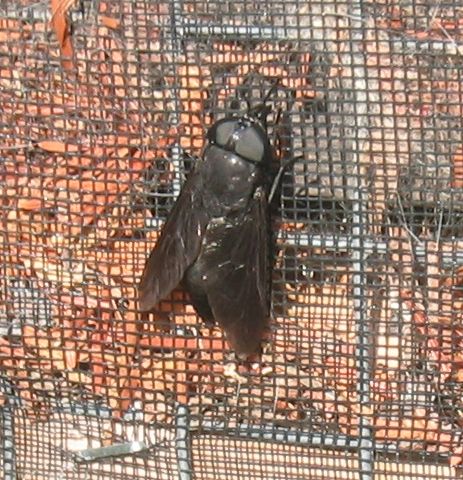
One of the giant flies we used to see mid to late summer each year. The wire mesh behind the screen is 1 inch X 1 inch, so you can see how big these things were. These flies never tried to bite, and were almost tame - they made no effort to fly away, no matter how close you got.
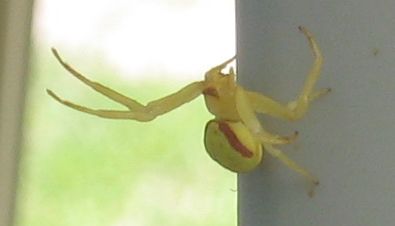
This is a picture of the Goldenrod Crab spiders that were around the cabin.
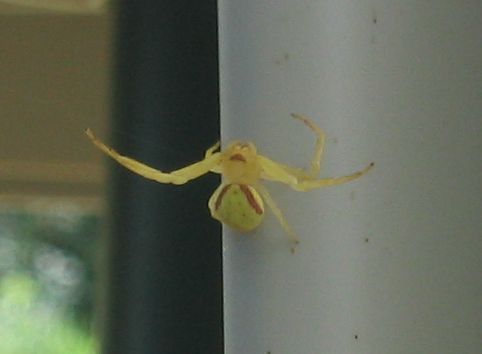
These pictures do not do them justice, their bright banana yellow was very beautiful.
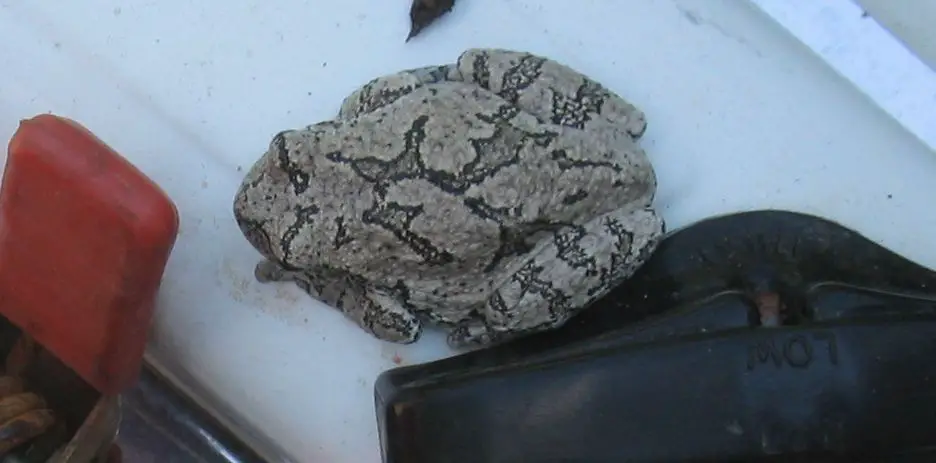
Picture of one of the Gray tree frogs that were around by the back door. This one is on the wringer part of the wringer washing machine I had.
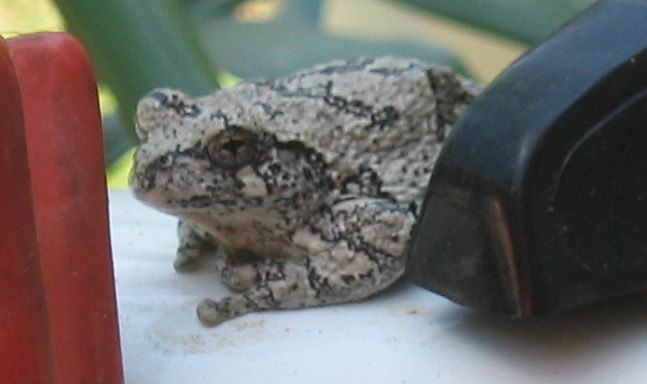
This frog didn't seem nervous of me at all. I got right in with the camera, and it just watched me take the pictures.
One day I got a phone call from Elva across the road. She said there was a moose in my driveway right beside the cabin. I looked to the window to my left – the phone was by the chair very close to the window - and there was a moose looking in the window at me. It was the first time I'd seen a moose in my life. I went out the back door to get a picture of it, but by that time it was heading down the driveway to the road. It made a left turn onto the road and trotted down the very centre of the road until it disappeared.
Wild turkeys were another common sight. The yard was part of the trail that they used daily in some seasons. They would cross over the yard, cross the road, turn right and walk along in front of Bill and Elva's place. They used the same route day after day, at about the same time every day.
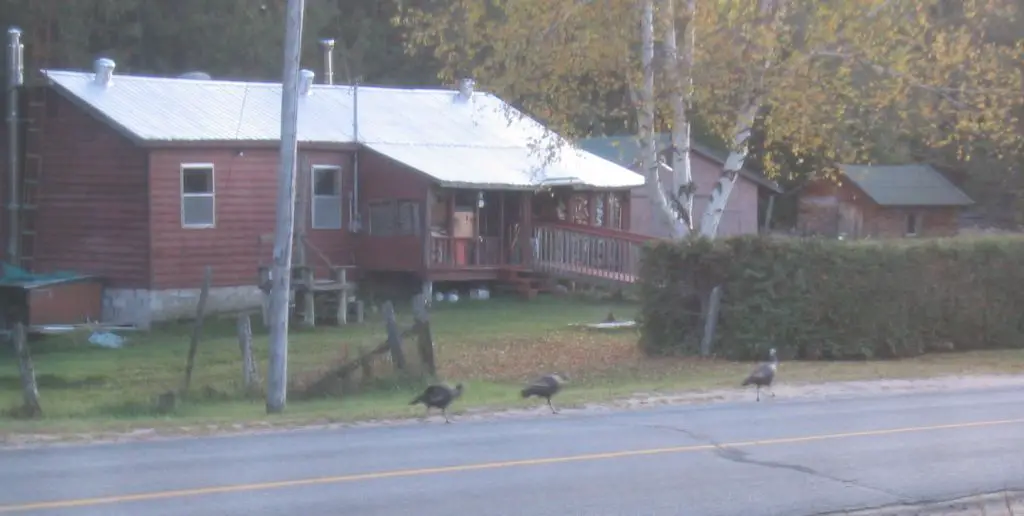
Wild turkeys passing by Bill and Elva's place.
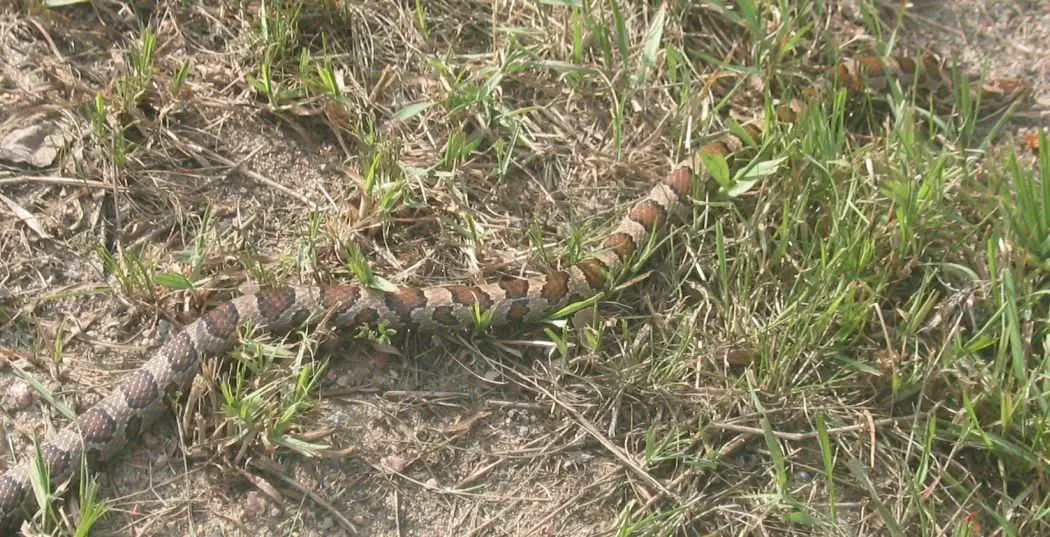
There were a lot of milk snakes around. My experience is they can be aggressive but harmless. This one was close to five feet long and was not happy when I carried it out of the cabin and put it on the grass. It turned around and came back toward me, then changed its mind.
One thing there seemed to be more than enough of was so called “dock spiders”. I had first found out about them visiting a cottage in Upper New York State. I know they are not dangerous, but the size of them can make you shiver when you see one unexpectedly cruise by. And they can move very fast.
I'm not a bird specialist, I enjoy watching them, but don't know many names. What I can say, is that there were a lot of different birds around. Lee, the grandson of the man who built the cabin was an avid birder, and was always pointing out some interesting bird to me when he was visiting. Pheasants were common. One other there were a lot of were Ravens. In Southern Ontario, Crows were common. In the area around the cabin I never saw a crow, yet numerous Ravens. The purple colour in light at the right angle is beautiful.
Weather
The weather there is not what I would have expected. The cold and deep snow I did expect. What took me by surprise was the number of wild summer storms with tornadoes.
On the scouting trip in April of 2006, near where the cabin was located, there was a sign by a flattened section of forest stating this was an area that was hit by a tornado. I thought to myself, “that must have been a one off this far north.”
I couldn't have been more wrong. The giant white pine that was in our yard was broken off by a tornado on August 02, 2006, not long before we moved in. Our yard just got clipped, but across the road from our property was woods that was flattened.
On August 20, 2009, in the evening, a storm went through that is the worst I've ever experienced. I was working in the garden after supper, when I looked west to the cabin to see the cats in the pen, when at first glance I thought I saw pitch black mountains that hadn't been there before.
When I realized how bad this storm must be, I dropped what I was doing and began driving long metal stakes into the ground around the cat pen and securing it with rope. I didn't want it flying away.
Just as I was done, and about 15 feet from the back door, a gust of wind came that knocked me to the ground. I was on the ground before I realized what was happening. When I raised my head, I was looking east, just in time to see one of the red pines in the plantation flying through the air – upright – and strike the power lines, snap in half, and get blown into the garden.
I ran into the cabin and started stuffing cats down the trap door in the main room into the basement. It was a waste of time. Each time I tried to put another cat down, one or more would pop right back up. I knew I'd never get them all down there, so I gave up after a few tries, and went up to the loft where the cats were now hiding from me to weather the storm. I figured we will all live or die together.
When that storm hit a few moments later, it was something. Bits of trees were bashing into the cabin, sheets of rain made it impossible to see out the window. There was an almost constant screaming sound of the wind. I was glad the window I had made for the loft was Lexan, and not glass when it was hit by a branch.
After what I'm guessing is five to ten minutes of this, I heard what really did sound like a train going by.
We survived unscathed. A few days later when out on the trails, I found an area that before the storm was dense forest, now just flattened. I knew that area very well, as it was a section of trail I used regularly. I used to marvel at the size of the trees, and how dark it was inside these woods. The flattened area was very wide, as far as you could see both east and west. In that swath almost nothing was left standing.
I have never seen destruction like this before. Trees twisted around 20 feet off the ground. You could see they had been spun around and around.
The absolute worst destruction was on a tiny trail that ran off of the V Lake trail east of Venalen Lake. From the top of a hill there, you got a good view of the trail of destruction. This was a trail that would be accessible by dirt bike, ATV or foot only. V lake trail is big enough for a four wheel drive. By the way, Venalen Lake is a tiny lake and doesn't show on all maps. Go here on Google maps to see where I mean. You can see the north to south hill just east of the lake I'm referring too. The little trail off of V Lake trail does not show on the map, but goes over this hill right near the south end of it.
There is a Wikipedia entry for this storm Southern Ontario Tornado Outbreak of 2009 and two thirds of the way down the page it talks about the damage in a subsection called "Eastern Ontario tornadoes". It says, "..in Bancroft/Carlow Mayo area the produced F1 caused damage to trees and hunting cabins". If that is what an F1 can do, I don't even want to think about a bigger one going by.
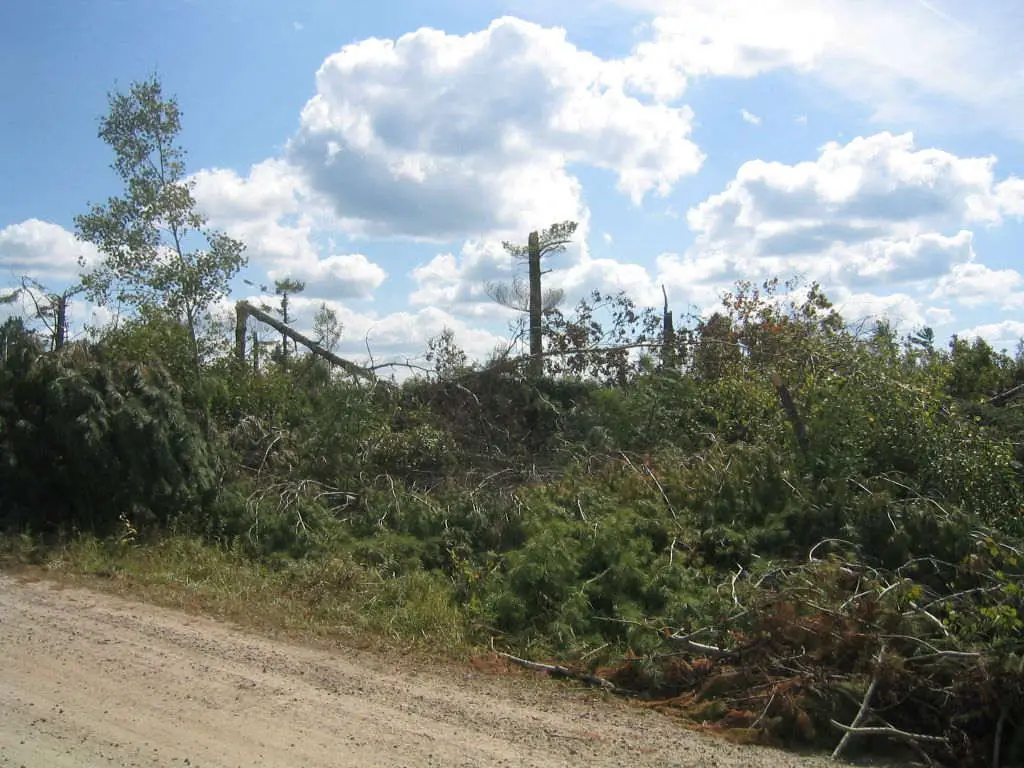
This area was dense dark forest before the tornadoes went through. This is about 5.5 km south/east of the cottage.
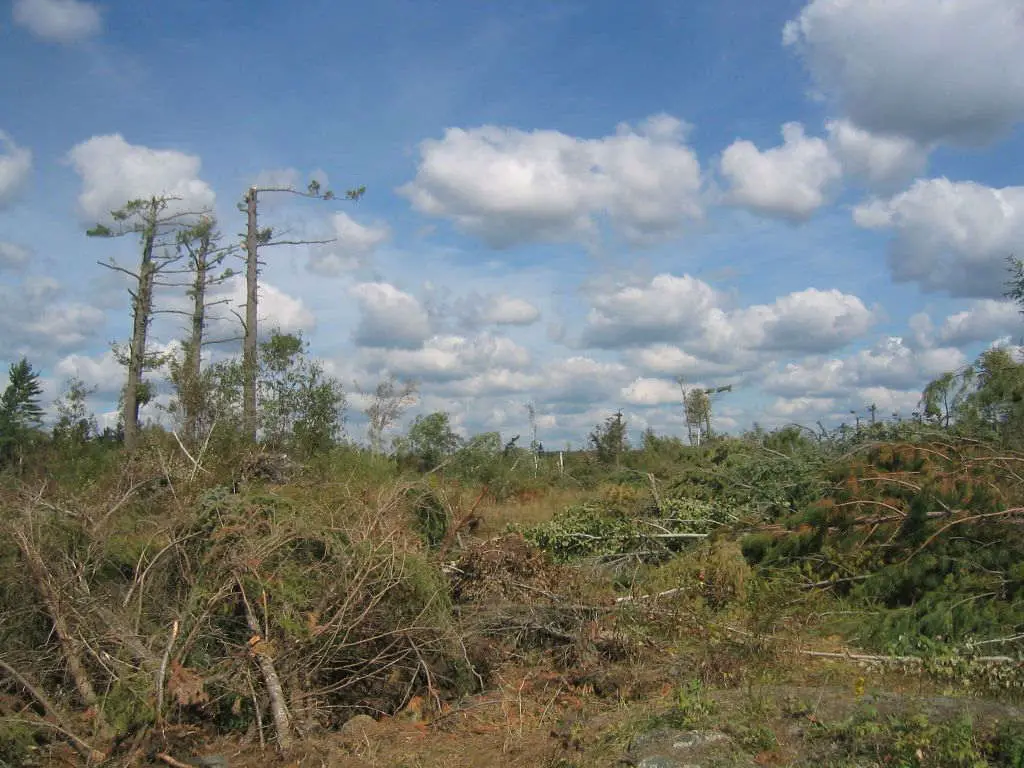
This picture speaks for itself.
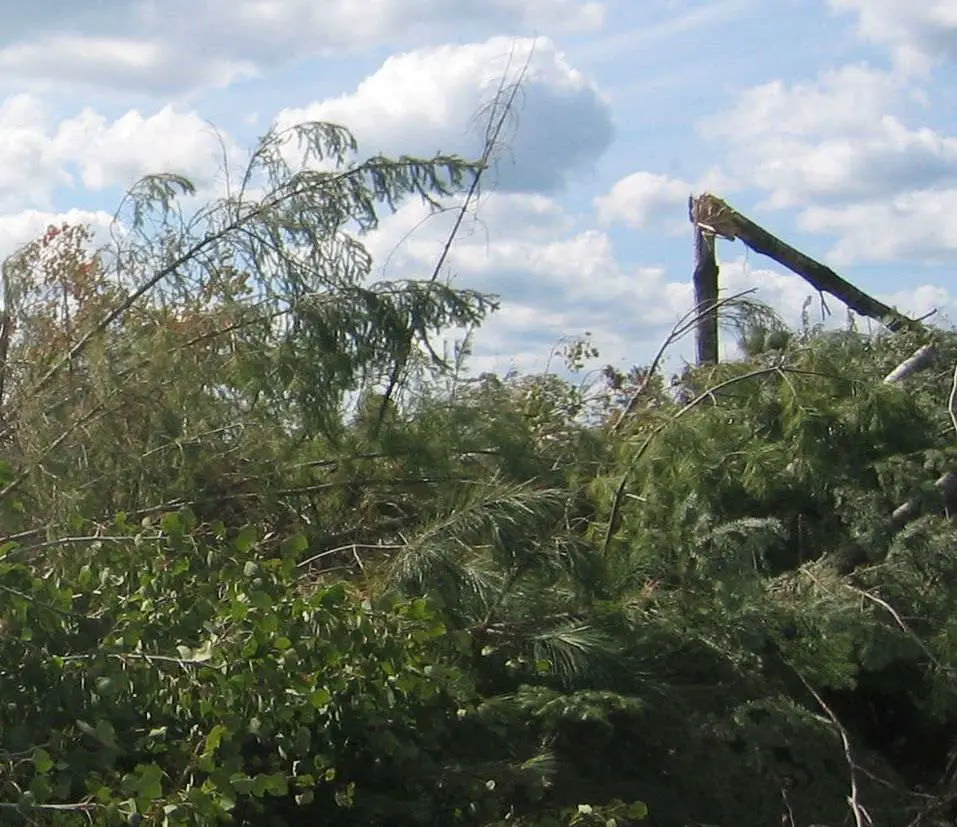
You can see the pine in the right of the picture is spun around until twisted off.
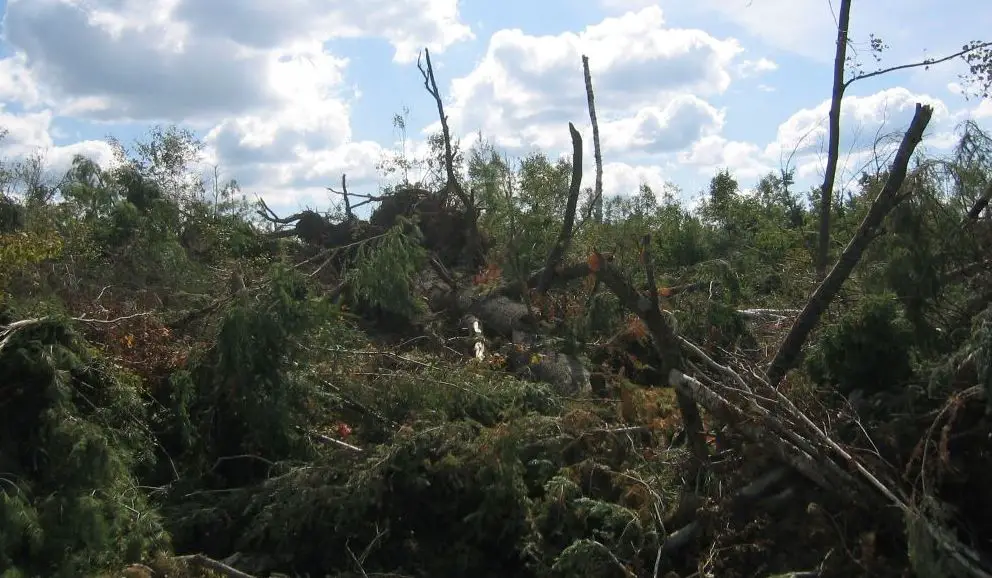
Big trees uprooted and smashed to bits.
The Wilderness and Trails
The area around the cabin was very beautiful. In fact, the road the cabin was on was a designated Scenic Route. I had a road legal dirt bike that I used to explore the area and trails, and was never tired of just looking around.
There were big, idyllic lakes, marshland, cliffs, huge hills that in some cases are actually called mountains on maps, but nothing on the scale of the Rockies. They are so old, they are worn rounded.
There was a huge array of tree types, plant types and mushrooms. I have been interested in all three for many years, and have a decent amateur knowledge, so this area was a wonderland for different species to look at.
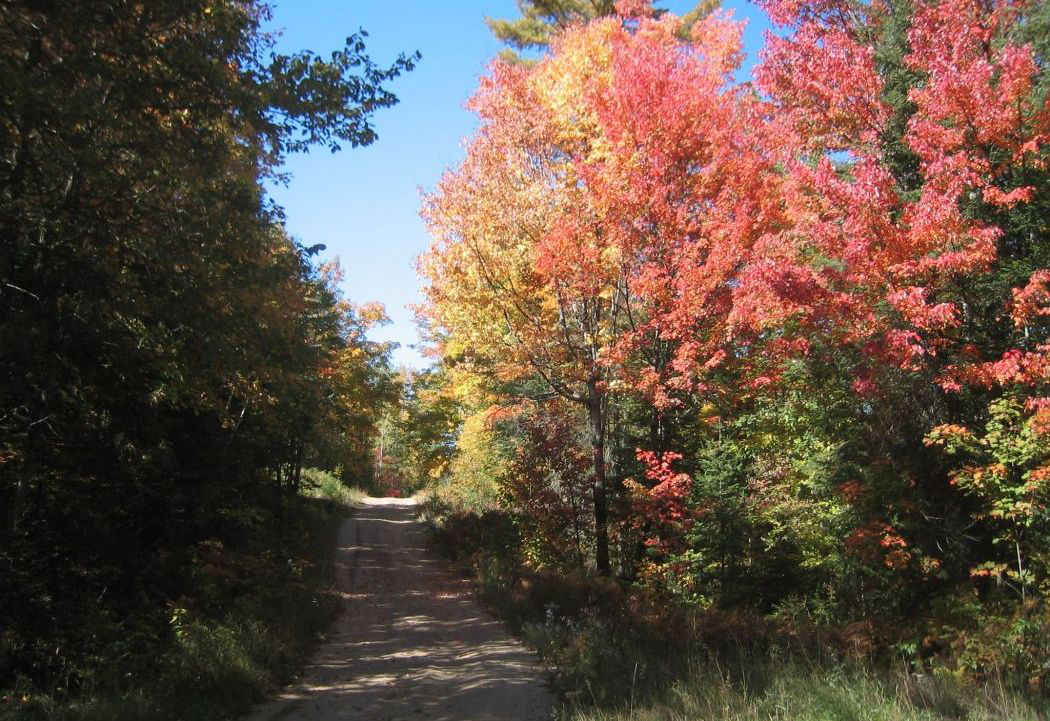
One of the many hundreds of miles of trails in the area. My worst fear was getting lost, so I kept a GPS on me. I was living alone in the cabin, and getting lost meant really being lost, as nobody knew I was even out. There was no point in having a cell phone, as there was no signal available at the time. I always kept my motorcycle in top shape, as a breakdown miles from home was a frightening thought alone in the woods. But I went out anyway, it was too beautiful to miss.
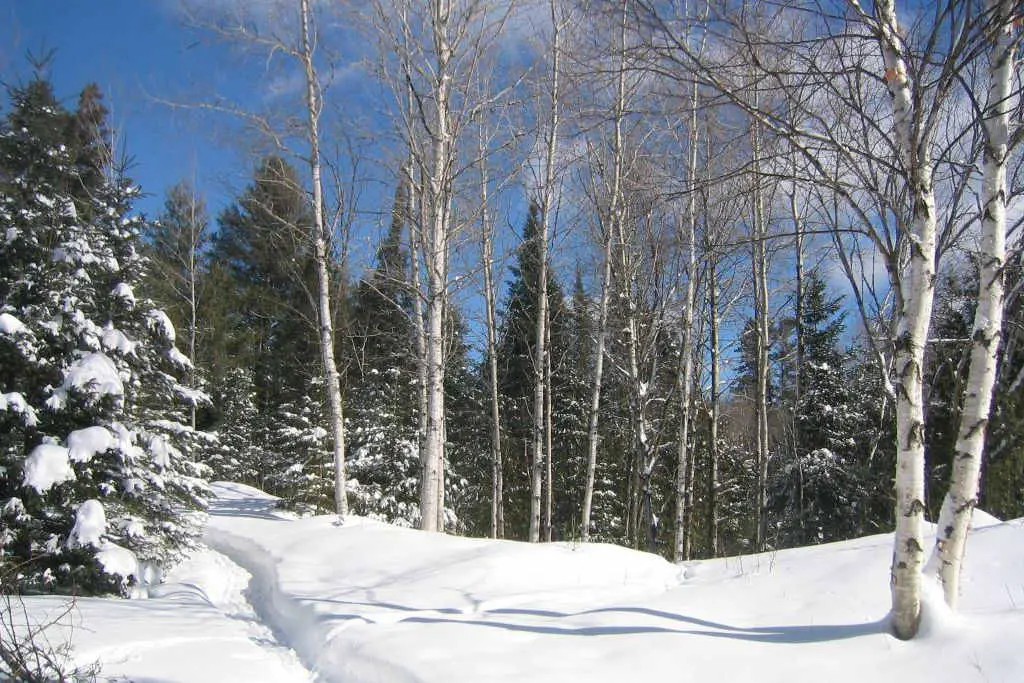
The back part of the yard near the cliff in the winter. It really was a beautiful property.
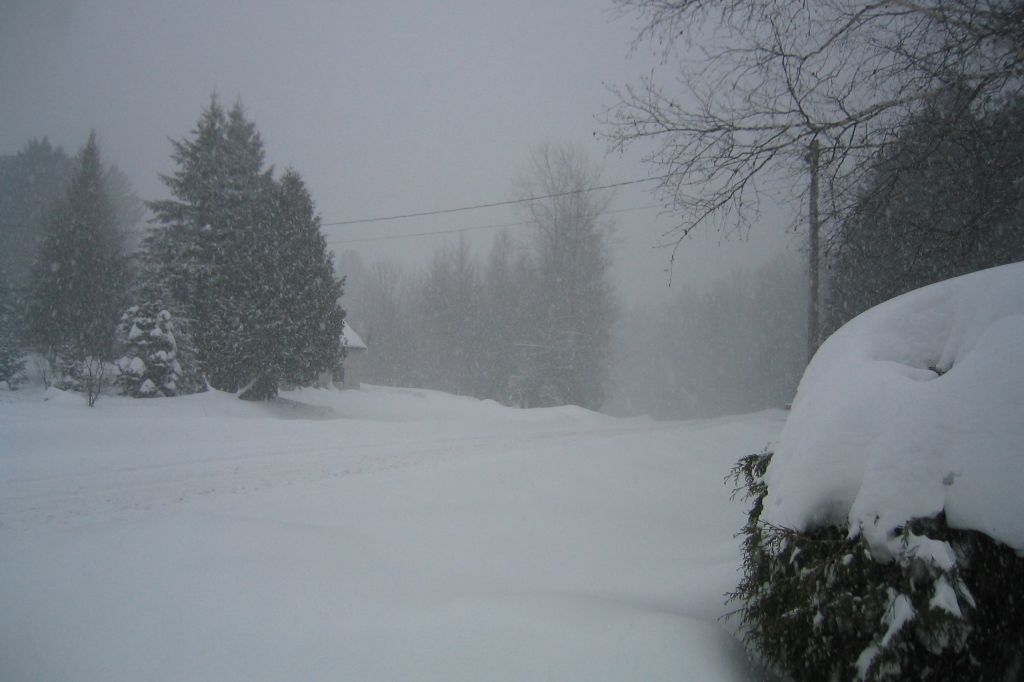
Looking at the cabin from the neighbours driveway in a winter storm. Unlike in the city, nature, weather and wilderness predominated over human activity.
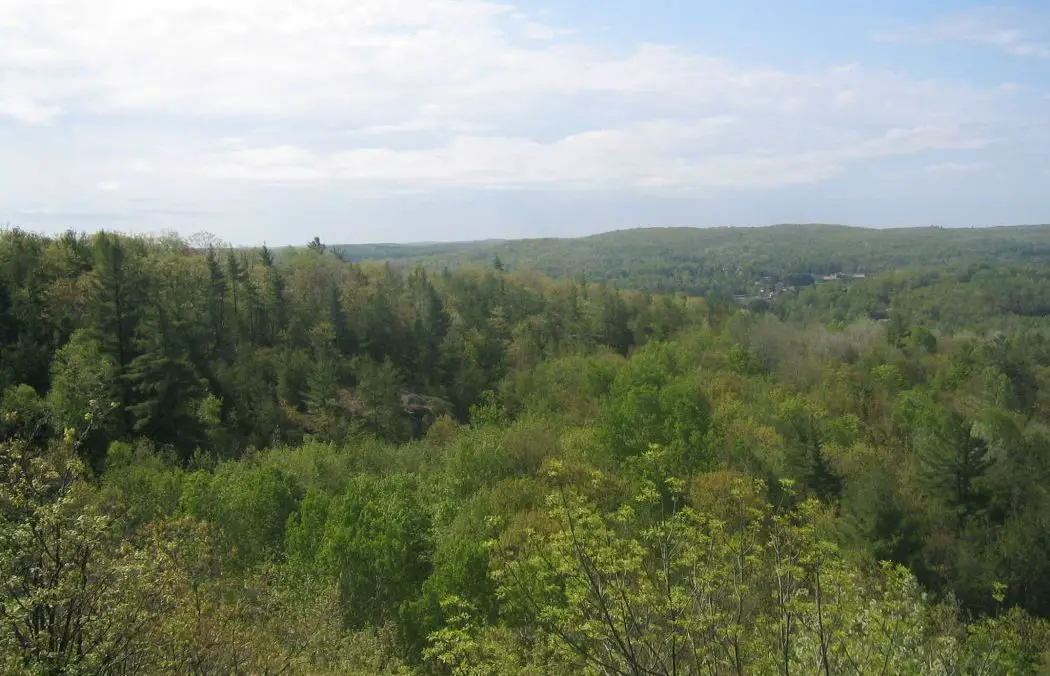
This picture gives a good idea of the overall area the cabin was in. It is taken from a high point called “Eagle's Nest”.
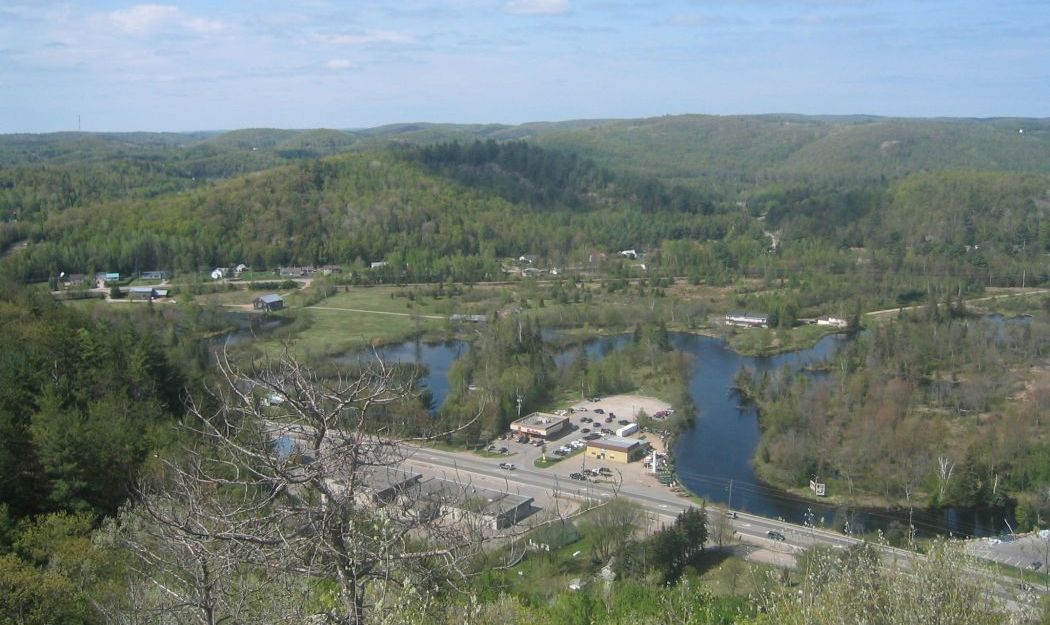
Another picture taken from Eagle's Nest. The town of Bancroft is below.
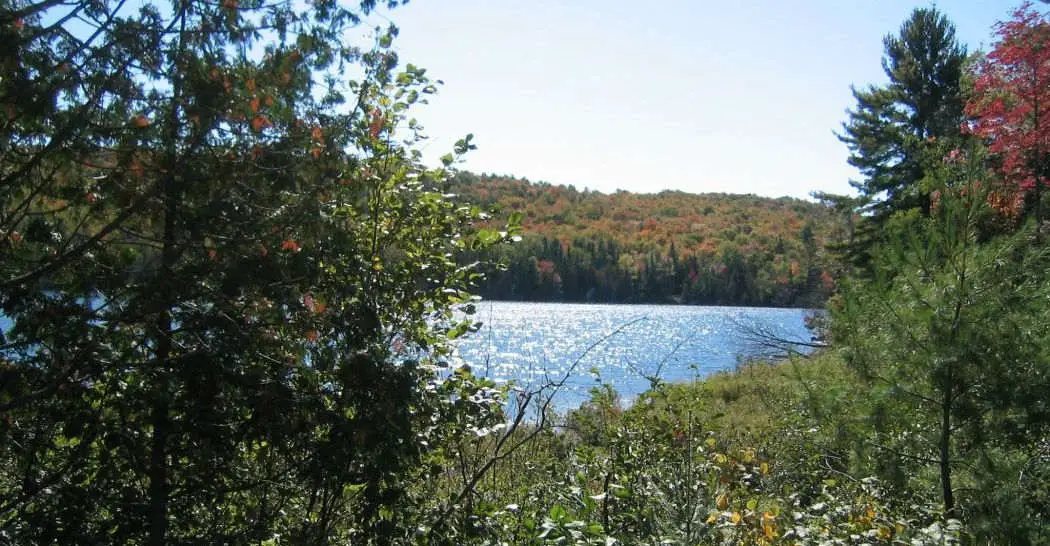
Bessemer lake from one of the trails. There used to be an iron mine under this lake before it closed around 1906. The trail is the remnant of the rail line used to haul out the ore. The name Bessemer comes from the Bessemer process of making steel.
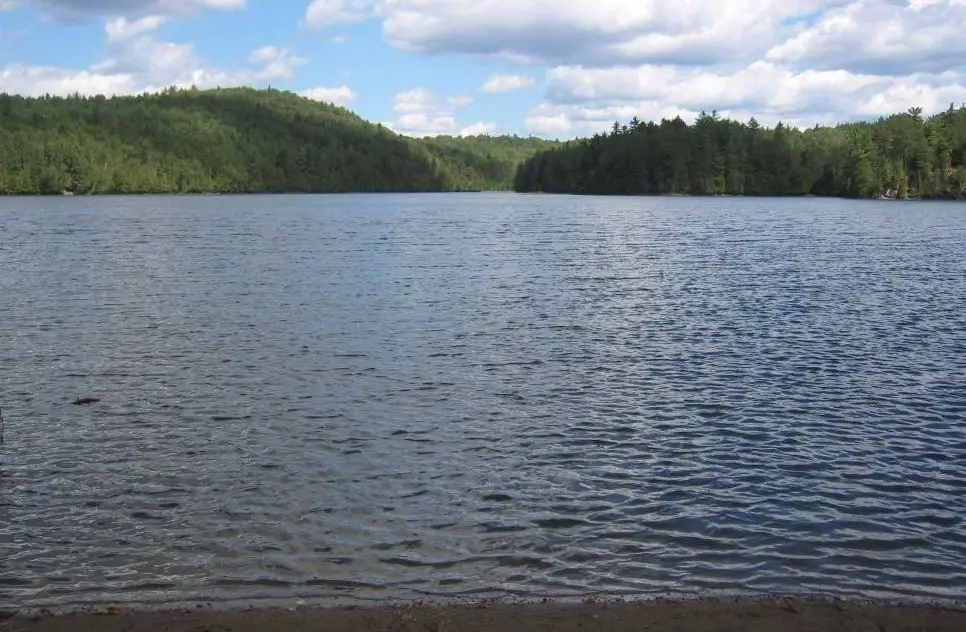
V Lake from the V Lake trail.
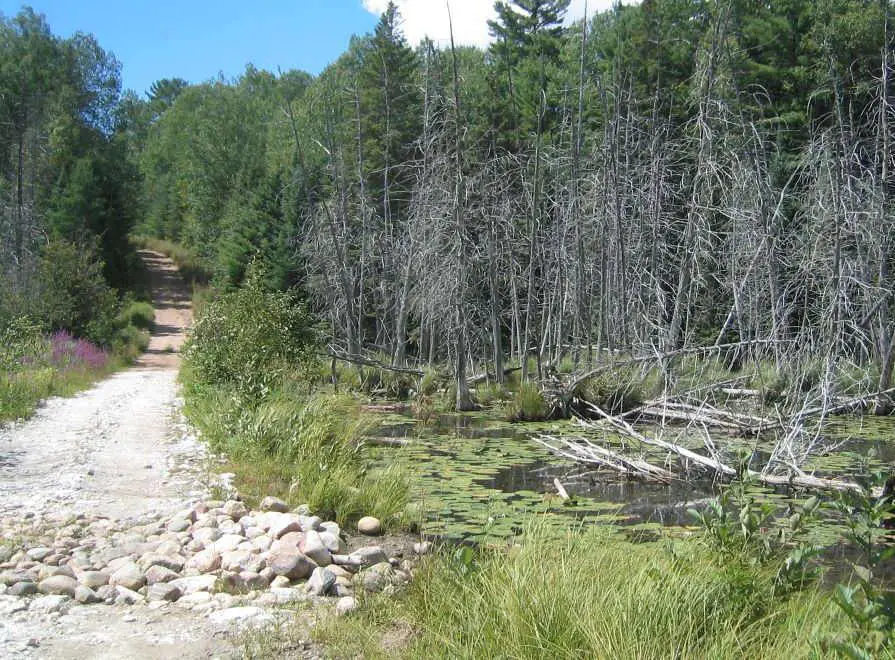
Part of the Swordfingal trail very near the cabin. This area is so beautiful.
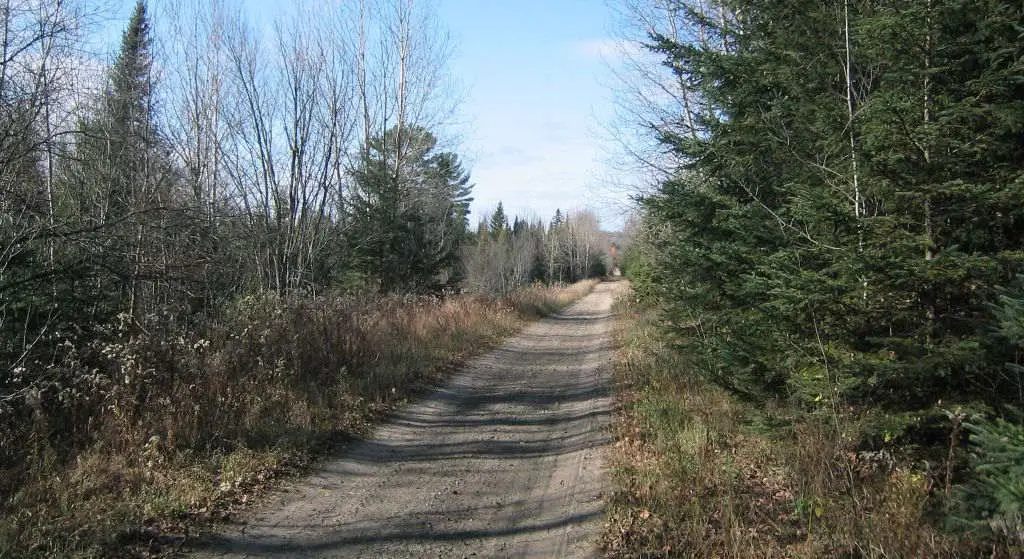
Heading to town along the B106 trail from the cabin. The B106 main trail was about half a kilometre from the cabin and went right into town. I loved going to town on the trail.
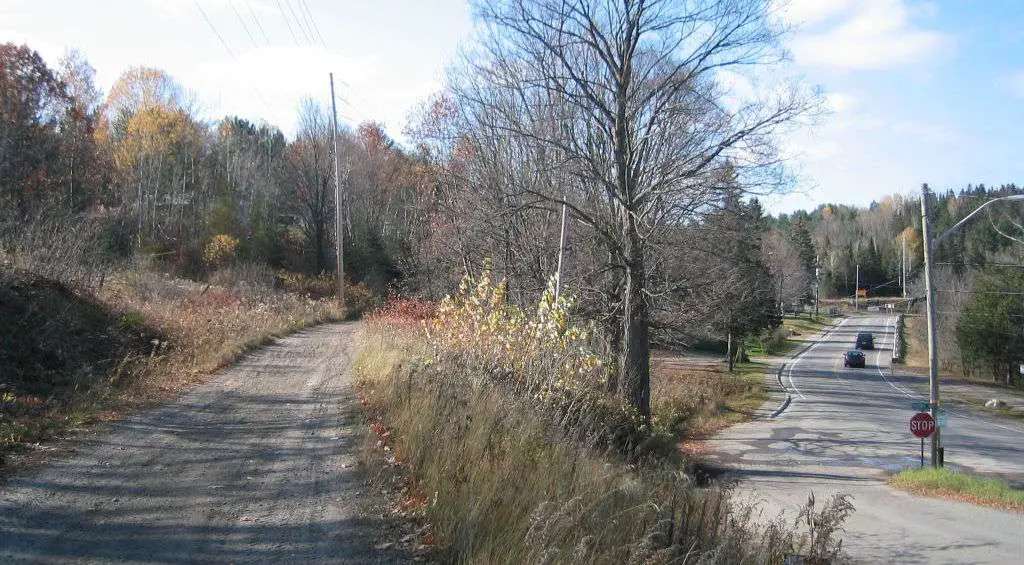
Entering the town of Bancroft on the B106 trail.
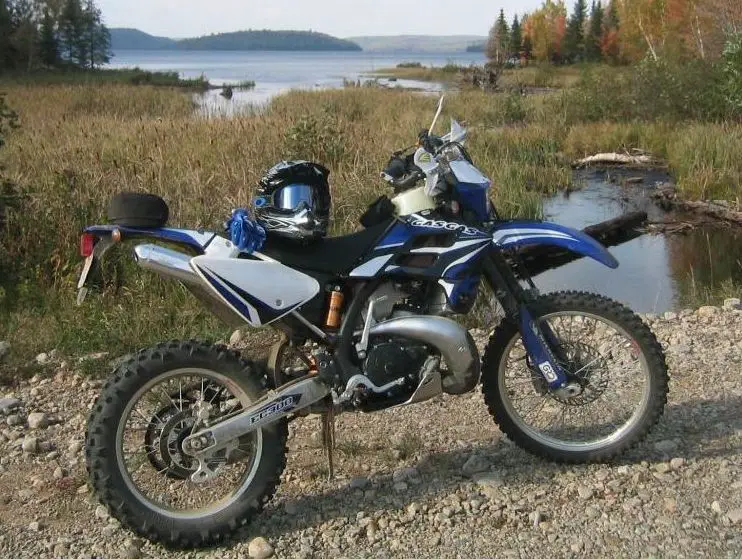
The motorcycle I used to explore the area. The five years I was up there, it never let me down once. It was made in Spain, a “Gas Gas EC300”. Lake behind is Aylen Lake by the east side of Algonquin Park.
The Sky
There was an observatory just two roads south of me. I found out the reason it was here was, this was one of the darkest places at night in the south part of the province - very little if no light pollution. I can confirm this was true. If it was a new moon, and it was overcast, you could go out at night and literally not be able to see your hand in front of your face. It was pitch black, something I'd never experienced in the city.
On clear new moon nights, the night sky was something I had never seen before coming from the city. You could see the milky way perfectly clearly. There were a couple of clear new moon summer nights I got on the roof covered with bug spray, with blankets and a pillow, and just looked at the sky until I fell asleep. I watched satellites go by, saw planets, everything you could see with binoculars. It was beautiful.
One thing I never saw was a flying saucer. I bring that up because very close to the cabin in a place called Gilmour was a man named Dave Hamel, who was known as the "Granite Man of Gilmour". He died while I was living there. There was a book written about him called, "The Word Made Manifest Through Sacred Geometry" by Robert Thomas. It is a book about the technology Mr. Hamel used to build a three stage craft he called "Galaxy Trinity". Another book written about him called, "The Granite Man and the Butterfly" is how he got the name.
Dave Hamel claimed that the technology was given to him by aliens who took him into their ship. The butterfly reference was about how rings of magnets would power the ship. Granite was also used in the ship he was building, which he claimed would turn into glass when the ship was in space.
Supposedly, his first attempt worked when he lived in Maple Ridge, BC. It exploded after 12 minutes of use. His second attempt started to produce bright light that drew a crowd, then the circular device rose straight up into space in front of the witnesses. It also knocked out the power in the neighbourhood.
In 1977 he claims he was taken from Maple Ridge, British Columbia, to Gilmour, on Beaver Creek, just south of where the cabin is. They wanted to show him this area and have him move there. During the trip, he had the technology imprinted in his mind how to reproduce it for a spaceship arc that would save some people in the upcoming turmoil on earth.
Now you can see why I was disappointed in not seeing a flying saucer. There were so many times when things were not going well, and I was tired of not having running water, being broke and alone, I wished one would land in my yard and take the cats and me to another planet.
By the way, Dave Hamel wasn't the only famous person right by.
One day, I got a knock at the door which turned out to be a courier delivering a book I had ordered. The courier and I started talking about stuff and joking around. After laughing at something I said, he said to me, "You are just like your neighbour". I replied I didn't know the neighbours except for the couple across the road. He looked at me, and said, "Your famous neighbour". I said I still didn't know who he was talking about. He looked at me inquisitively to see if I was telling the truth, then said, "Right over there on the other side of the hill on the little side road lives Jim Carrey". I said, "The actor Jim Carrey"? He laughed and said yes. I politely said that was amazing, but I didn't believe him. Jim Carrey would surely live in California, not the woods. Turned out, he was telling the truth. Jim Carrey owned a vacation home where the courier said. I found out when there was a request to change the name of the lake he was on to the name of his daughter.
Clouds were more interesting there than I had seen before. With thousands of acres of shallow wetland around, I could watch clouds form on hot sunny afternoons. I probably took over a hundred pictures of clouds.
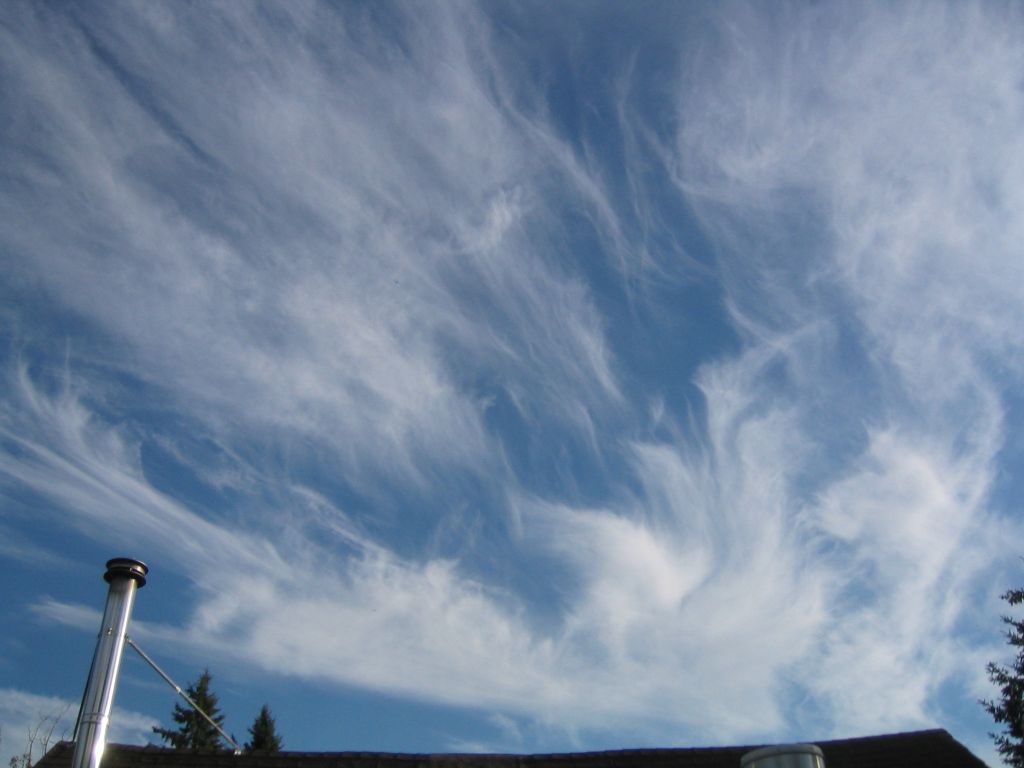
I wish pictures could do justice to what this really looked like.
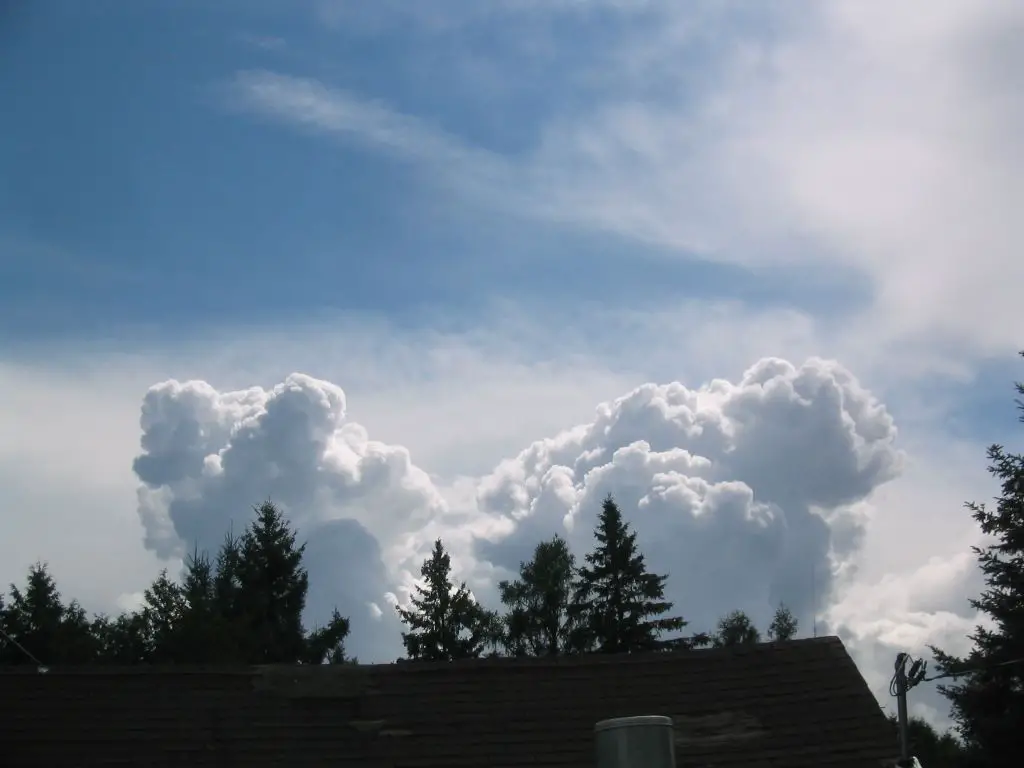
This was taken on a day when the clouds were forming over the marshland to the south. I watched them just pop up on the weather radar, as I watched them pop up in front of me. This is one starting.
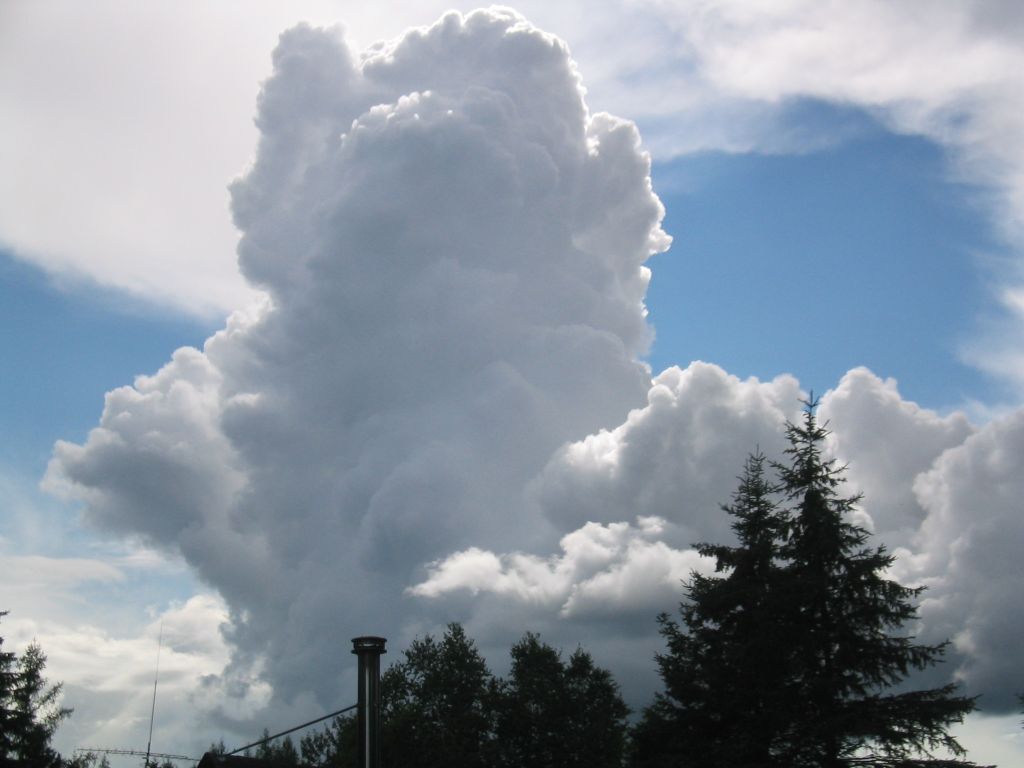
This is a few minutes on after the previous picture. This particular one grew and grew, and gently blew north. You could see it appear on the radar, then move off.
Sunrises and sunsets were stunning over the forests on many days. Now that I'm back in a city I truly miss the beautiful skies. I finally understand the fascination with the skies the ancients had before electric lighting.
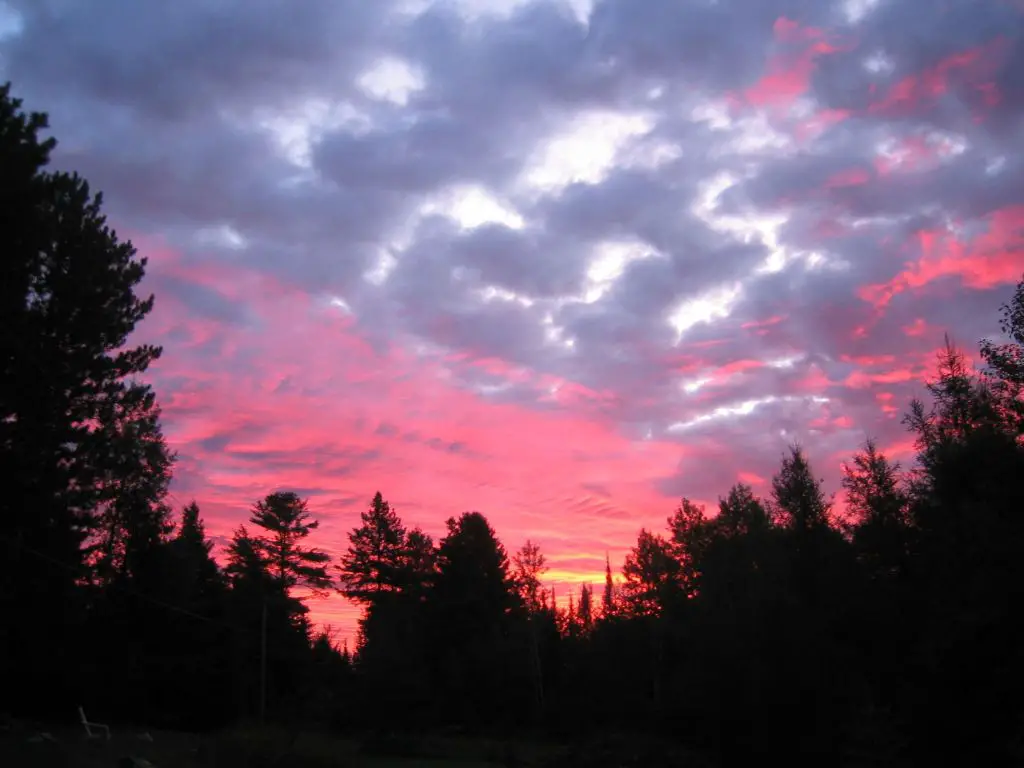
Sunrise over the yard.
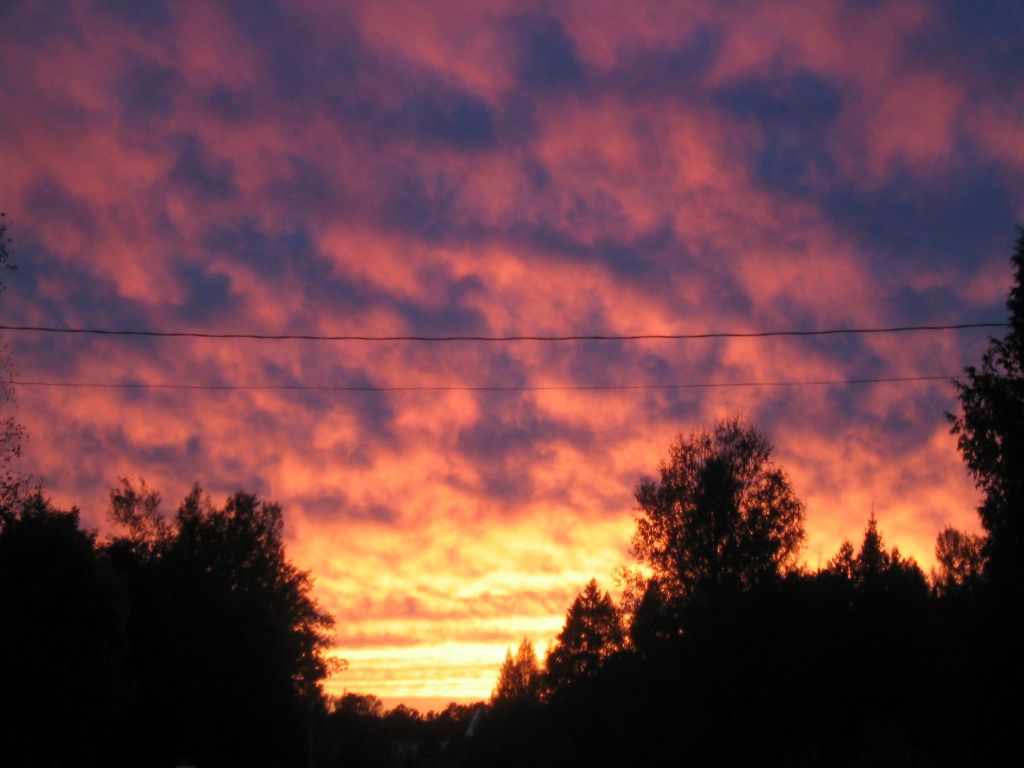
Sunset from front of cabin.
Tacky Moose
I made a moose for the yard one day on a whim. The body was made from one of the very large branch logs from the giant white pine. A curved section of red pine for the head, some cedar branches for antlers, and red pine logs for the legs.
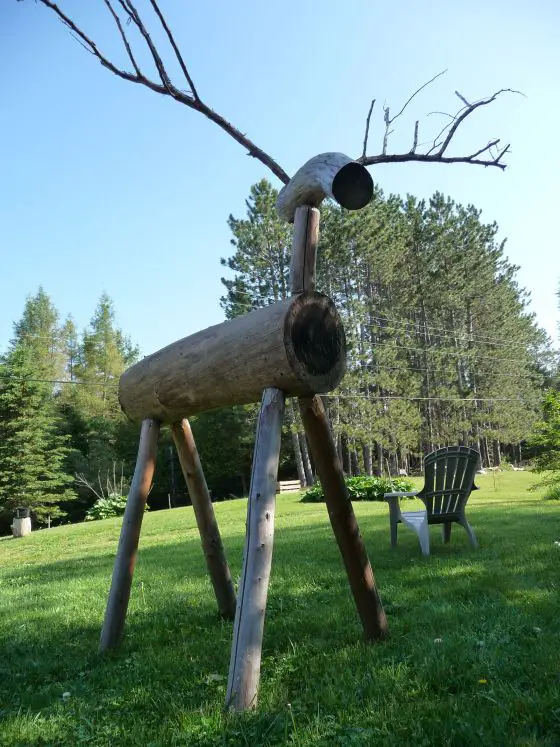
The moose. The top of the head was about six feet, six inches off the ground. Photograph by Pamela J. Walsh.
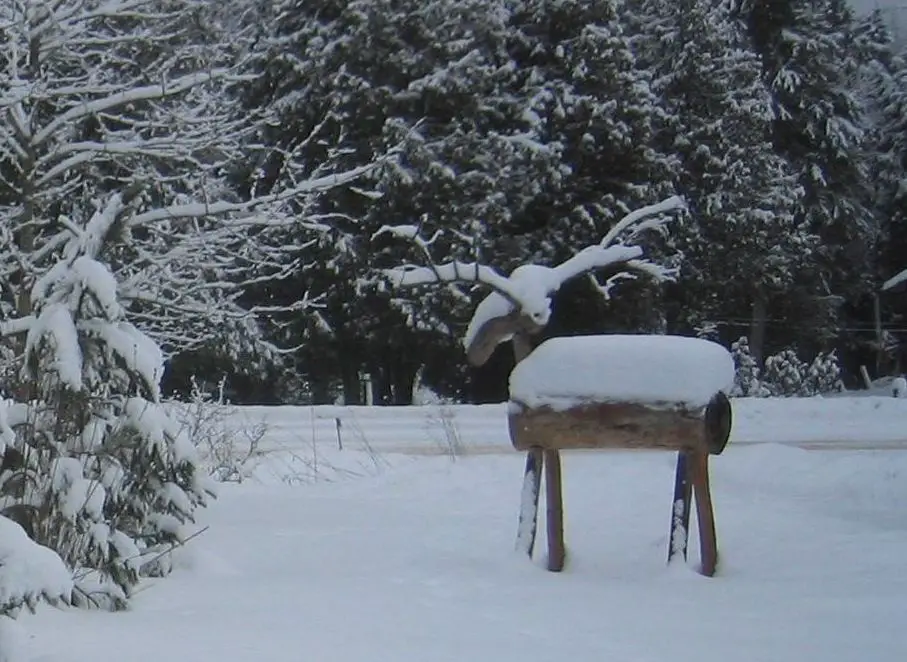
The moose in winter.
Share:
Why does this site have ads?
Originally the content in this site was a book that was sold through Amazon worldwide. However, I wanted this story available to everyone free of charge, so I made this website. The ads on the site help cover the cost of maintaining the site and keeping it available.
Google + profile
